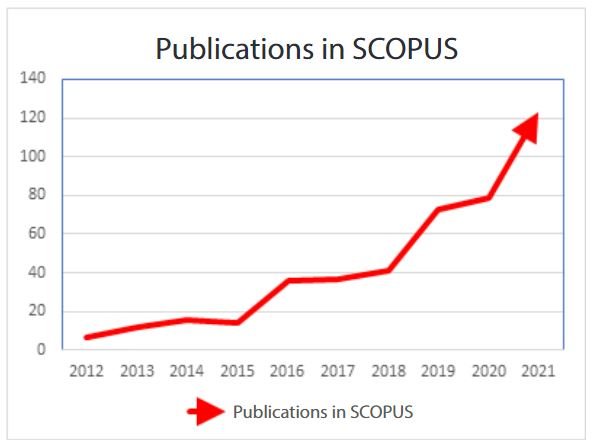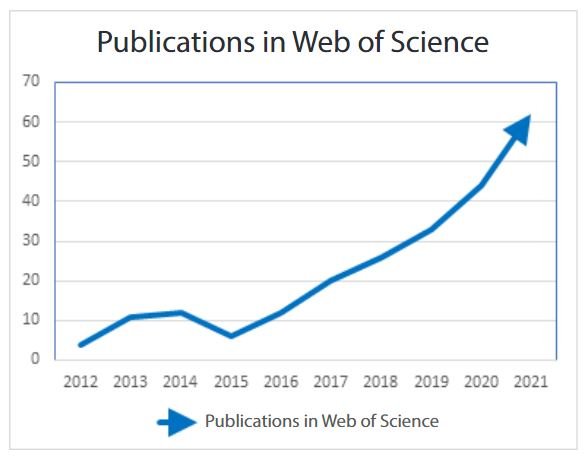EDITORIAL
REVISTA DE LA FACULTAD DE MEDICINA HUMANA 2022 - Universidad Ricardo Palma10.25176/RFMH.v22i2.4895
ACHIEVEMENTS AND AN OUTLOOK OF 2012-2021 RESEARCH: INSTITUTO DE INVESTIGACIONES EN CIENCIAS BIOMÉDICAS OF UNIVERSIDAD RICARDO PALMA
LOGROS Y PERSPECTIVAS DE LA INVESTIGACIÓN 2012-2021: INSTITUTO DE INVESTIGACIONES EN CIENCIAS BIOMÉDICAS DE LA UNIVERSIDAD RICARDO PALMA
Jhony A. De La Cruz-Vargas1,a,b, Dante Quiñones Laveriano1,c
1Instituto de Investigación en Ciencias Biomédicas (INICIB), Universidad Ricardo Palma,
Lima-Perú
aMedical specialist in medical oncology
bDoctor of Medicine
cMedical surgeon
We present an overview of the evolution of scientific publication, which constitute a real and objective indicator to visualize the trends and projections of research at the Faculty of Human Medicine and at Universidad Ricardo Palma. For this, we will take as reference the records of international bases of recognized prestige as SCOPUS and WEB OF SCIENCE.
EVOLUCIÓN DE LA PRODUCCÍON CIENTÍFICA
SCOPUS
If we look at table 1 and Figure 1A, the evolution of the
number of scientific publications is clearly shown in an increasing and progressive manner in the SCOPUS
database(2).
From 2016 we can see an inflection, which is maintained upwards in a sustained way. A final
achievement is that, in the second semester of year 2021, INICIB implemented the "Special Program 100 x
100 URP"(3), which allowed the incorporation of new research teachers, with
the objective of surpassing the threshold of 100 publications per year with affiliation of Universidad
Ricardo Palma. The result was that in 2021 this goal was reached and exceeded, reaching 123 publications
in SCOPUS.
WEB OF SCIENCE
Similarly, this pattern is repeated when we observe the evolution of the publications made in
the Core Collection database of WEB OF SCIENCE(4) in table
1 and more clearly in Figure 1B. WEB OF SCIENCE contains some of the most
prestigious databases worldwide, and the Core Collection is one of the main, as it contains a reliable
and high quality collection of scientific journals, books or other sources that undergo a rigorous
selection process and constant evaluation to prove their permanence.
The increase in publications in this database is indicative, not only of the great advance in
boosting the number of publications, but also of the higher quality with which research is carried out
in our university, and can be published in the best journals in the world.
OUTLOOK
The path traveled in the last ten years at Universidad Ricardo Palma, leaves us some lessons:
First, research and the generation of new knowledge is the hallmark of the universities of the 21st
century, in a context of greater competitiveness and facing the challenge of the transition from
professor-only universities to universities with qualified research professors registered in national
and international research systems. It is hoped that there will be not only one teacher in the higher
education institution, but also a researcher who helps to improve academic conditions and generate
scientific and social development(5).
The second lesson is the importance of motivating and incorporating research teachers as a
priority policy in universities. The allocation of resources and the development of infrastructure must
accompany the institutional political will to promote research in universities by decision makers.
Breaking the historical inertia and moving towards the university model generating new knowledge is a
challenge and a necessity.
The third lesson is that the cooperative and collaborative research model, involving national
and international networks, helps and enhances scientific production results(1).
Strengthening research institutes and centers that have qualified human resources and experience
in scientific research and production seems not only strategic but high priority to follow the trend of
momentum and continuous quantitative growth as qualitative of university research(6,7).
To develop models and special programs aimed at promoting, strengthening and raising the
scientific production of Universidad Ricardo Palma, constitutes a strategic pillar for the present and
future of the institution, linked to its academic prestige, its role with society and the country, its
accreditation and licensing indicators, its national and international positioning and the scientific,
technological and innovation development of its teachers and researchers.
Table 1. Evolution of URP-affiliated publications in SCOPUS and WOS
| Year |
Number of publications SCOPUS |
% of growth (SCOPUS)* | % accumulated (SCOPUS)** |
Number of publications WoS |
% de growth (WoS)* | % accumulated (WoS)** |
|---|---|---|---|---|---|---|
| 2012 | 7 | -- | -- | 4 | -- | -- |
| 2013 | 12 | 71.40% | 71.40% | 11 | 175.00% | 57.10% |
| 2014 | 16 | 33.30% | 128.60% | 12 | 9.10% | 71.40% |
| 2015 | 14 | -12.50% | 100.00% | 6 | -50.00% | -14.30% |
| 2016 | 36 | 157.10% | 414.30% | 12 | 100.00% | 71.40% |
| 2017 | 37 | 2.80% | 428.60% | 20 | 66.70% | 185.70% |
| 2018 | 41 | 10.80% | 485.70% | 26 | 30.00% | 271.40% |
| 2019 | 73 | 78.00% | 942.90% | 33 | 26.90% | 371.40% |
| 2020 | 79 | 8.20% | 1028.60% | 44 | 33.30% | 528.60% |
| 2021 | 123 | 55.70% | 1657.10% | 62 | 40.90% | 785.70% |


Correspondence: Jhony A. De La Cruz-Vargas
Address: INICIB, Facultad de Medicina Humana, Edificio I-208. 2do piso. Avenida
Benavides 5440, Surco, Lima-Perú.
Telephone number: 708-0000 / Anexo: 6016
E-mail: jhony.delacruz@urp.edu.pe
REFERENCES
